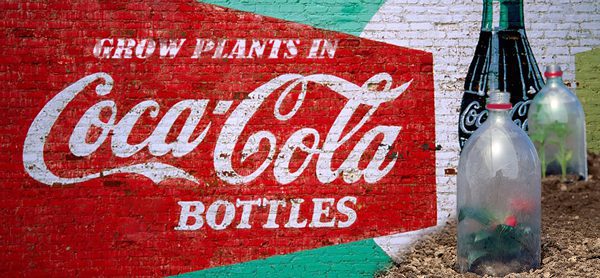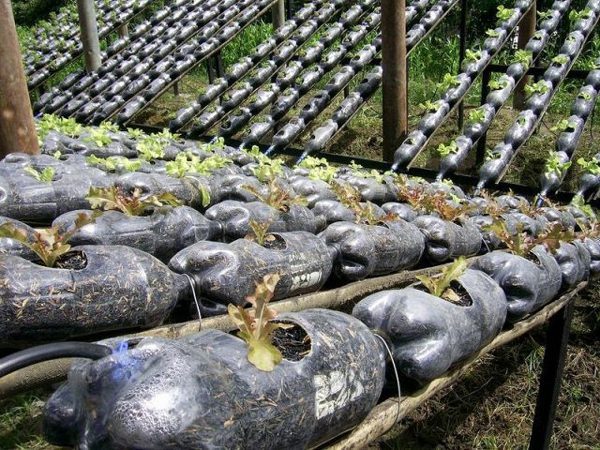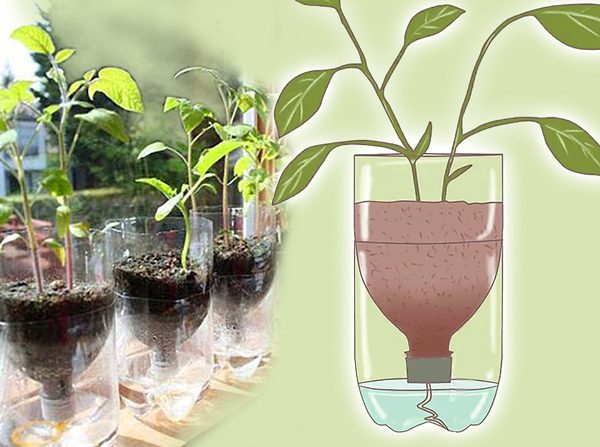Growing plants in empty 2-liter soft drink (PET) bottles is totally possible! Milk jugs and other types of large food-grade plastic bottles have a variety of gardening uses too. Use them for several different types of hydroponics systems or in more traditional forms of container growing.
The cost certainly can’t be beaten. Depending on where you live, unreturned pop bottles cost 5-10 cents each. In many places, they have no deposit, which means they’re free.
1. Passive Hydroponics
This is also known as a self-watering planter, or wicking – which is how seed starter trays work with the mat under the plant cells hanging into the water tray.
It uses the same principle as Earthbox, but you need a wick. People have good results with this setup using a potting mix, vermiculite, and clay pellets.
Paint the outside of the bottom half of the bottle to hamper algae growth in your reservoir.
Learn more about Passive Hydroponics.
2. Hydro Farming
Think that recycling used bottles is reserved for home growing? Not at all. A smart farmer will look for ways to upcycle because new tools and equipment cut into farm profitability. This setup could be engineered in a greenhouse too. This grower in Brazil has a sizable operation – all based on 2-liter pop bottles and hydroponics.
Learn more about Hydro Farming.
3. Closed System
The screw-top element of a soda bottle also lends itself well to a closed hydroponics system plumbed with PVC pipe.
This can be small with 10 planting spots or less, and it’s also scalable to a commercial size growing operation.
Here, the nutrient reservoir is a separate container. Note that the portion of the recycled bottles used was painted on the outside. Don’t forget that roots are subterranean dwellers. They don’t want or need light. The sun is only supposed to shine on leaf and stem.
You’ll find plans to build this system here. Look at all those bottles that didn’t wind up in a landfill. They will last many years being put to the task of growing food.
Learn more about closed systems.
4. Vertical Gardening
Whether you water by hand or hook up a pump, once again, the used pop bottle transforms into a container excellent for growing up instead of out. You can take advantage of either method inside or out.
Learn more about vertical gardening.
5. Window Farms
These can work with a pump and utilize passive hydroponics too. It all depends on how you set up your system, which depends on your budget.
You can also purchase a WindowFarms system, but know that the original design began with recycled bottles. This setup uses a pump to get water to the top tier plants, and drip irrigation to all those below.
Learn more about window farms.
6. Indoor Greenhouse
Keeping seeds consistently moist so they will sprout is a huge challenge without the right equipment. Use the bottom half to cover the pot to keep the surface from drying out.
Learn more about indoor greenhouses.
7. Drip Irrigation Reservoir
This works for container gardens, potted plants, and in the ground growing. The size of the bottle and your different needs will help you choose one of the above.
You can engineer the same setting using a drip catheter. You can jam a glass soda bottle full of water into a pot like these people. Or, take the easy road by suspending the bottle with a tiny hole in the lid above your planters (as seen here with recycled water bottles).
Learn more about drip irrigation.
8. Plant Containers
What is the difference between the bottom part of a soda bottle and a plant pot? Drainage holes, opaqueness, and perhaps a little style.
For some types of growing, portions of soda bottles, water bottles, and beverage jugs work great. Just make sure you’ve added drainage holes first.
Learn more about plant containers.
Updated by Catherine Sherriffs on 2020/04/02



I’ve made 11 of these so far . I need 25 , one for each fence post in my yard . I can’t wait for spring . No weeding . No varmints eating my garden . No bending over . A win win for me .
plastic cancer shit.. yum yum.. are u all dumb? i tried to avoid drinking from that, why would i for crist sick grow a food in that? u all wanna die? these bottles are made for one use, any manual damage causes spreading of chemicals in water, now in your soil.. sorry for english, i had to say something, We even had a negative influence of plastic bottle on humans health at school recently! and its high school – nothing special!
Hi Sandra,
Thanks for sharing this info. However, not everything you hear about plastic bottles is true. For anyone interested in growing food in used pop bottles, water bottles, or other plastic beverage bottles… make sure you know what kind of plastic it is. Most drinking bottles today are known as PET bottles, though some countries may not have switched away from plastics that contain BPA. PET bottles are BPA-free, and do not leach cancer-causing chemicals when reused. Here’s the facts from Snopes:
Even the American Cancer Society has debunked the claim that PET bottles leach dioxins or other cancer-causing chemicals. Lots more here on Snopes.com
Great idea.
I have been using polythene bags to carry out my indoor farming,which is very expensive both to buy and maintain.But with this great innovation i am going to become a role model in my community.
TOM
UGANDA
Best of luck, Tom 🙂
very nice this set up now a days looks very cheap to grow plants
Please Help me for The greenhouse on the roof
We’d love to answer you better, but there is nothing about a greenhouse on a roof in this post. All the directions we know to exist are linked to on this page – in the article or in earlier comments.
Hi,
how can i get set up plans for the hydroponic operation in portugal so i can replicate.
Thank you.
Delia- Uganda
Hello Delia,
The links with this information was just posted in last week’s comments above. Check out the pages in our response to Makgati right above your comment on this page. We have no other details, but it seems pretty easy to duplicate going by what you see in the images and the information on those two pages.
I want to build a hydro farm same as the that was built bythe grower in Portugal. Please send me the plan.
Hi Magkati,
We hunted down the only ‘plans’ for this hydro farm that are available. Here’s your links:
Both those sites are in a Spanish dialect, but you can easily translate it to English or another language with Google Translate.
Good luck with your build!
Hydro Farming
Think that recycling used bottles is reserved for home growing? Not at all. A smart farmer will look for ways to make use of what’s on hand, because new equipment cuts into farm profitability. This setup could be engineered in a greenhouse too for those of us not blessed with living in the tropics, or used just for summer growing. This grower in Portugal has a sizable operation – all based on 2 liter pop bottles and hydroponics.
CAN YOU PLEASE SEND ME THE DETAILS ON HOW TO BUILD THIS HYDRO FARM USING 2LITRE BOTLLES.(STEP BY STEP DETAILS WITH PICTURES IF POSSIBLE)
OMG this was soooo helpful, I have been wanting to start an indoor garden and needed some helpful and creative tips. Now I have container ideas, and watering ideas. THANKS!!!!!
Hi Laney –
I’m glad you found it helpful. Happy growing 🙂
hi this is very helpfull…… can u plz tell me what type of plants can i grow in soda bottles …… as my project
Hi Jam,
You will find that you can grow a wide range of garden plants in soda bottles, but approach your crop selection with some common sense. It’s not big enough for everything. Root crops like carrots, radish, and potatoes – it’s way too small. You might try a patio tomato, but a full sized tomato plant probably will suffer in such a small container. Herbs and lettuces, but plants that continue to increase in size long term where you pick the fruit will likely do well for a ‘season’. Like peppers – hot or bell – will probably do well for 6 months and then begin to show signs of not being real happy. The same with cucumbers, but it might be great for green beans – pole or bush. Of course with vines as cucumbers and pole beans are, you need a trellis and a lot more head room for raising the lights if growing indoors.
One thing to keep in mind about gardening is that experimenting is all part of finding out what you can and cannot do. But those tips should help you start the process 🙂
looking at these appropriate technologies, our efforts in Uganda have been inspired even the more. thank you very much for this link.
Hello Uganda – We’re glad to hear you found this post useful. Happy Growing 🙂
Im in Uganda have you done this here please ge tin touch i woudl like to see 0700195087
Hi Iqbal,
We don’t know of anyone growing in Coke bottles in Uganda. Sorry, but you’ll have to research that on your own.
If you wanted more information on the outdoor hydroponic bottle farm, everything we know is on this page. The site we found it on has no further details. It looks to be a drip irrigation system. The slanted racks use gravity to move water through the farm. It might be designed to recycle the nutrient solution.
Try putting that together in a small garden to see how it works. Trial and error, and modification is your best approach.
Good luck!